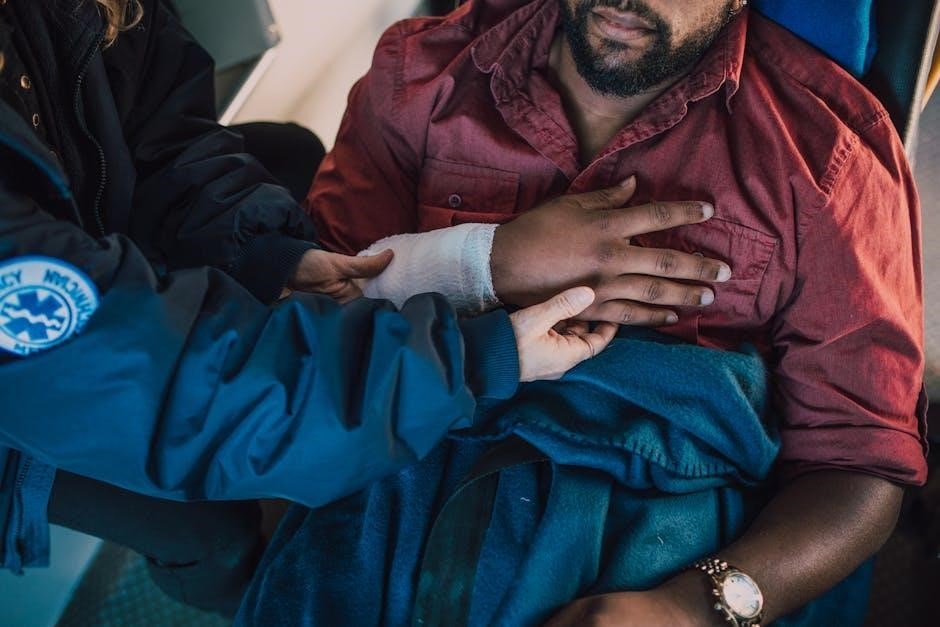EMT trauma scenarios are critical training tools, simulating real-life emergencies to enhance preparedness and decision-making skills for emergency medical technicians in high-stress situations.
Overview of EMT Training and Trauma Response
EMT training emphasizes hands-on experience and realistic simulations to prepare technicians for critical situations. Programs include classroom instruction and practical exercises in controlled environments, focusing on rapid assessment and effective interventions. Trainees learn to manage diverse trauma scenarios, such as multiple vehicle collisions and mass casualty incidents, while prioritizing patient safety and stabilization. The curriculum also covers emotional resilience techniques to help EMTs cope with high-stress environments. Continuous learning and adaptability are key components of modern trauma response training.
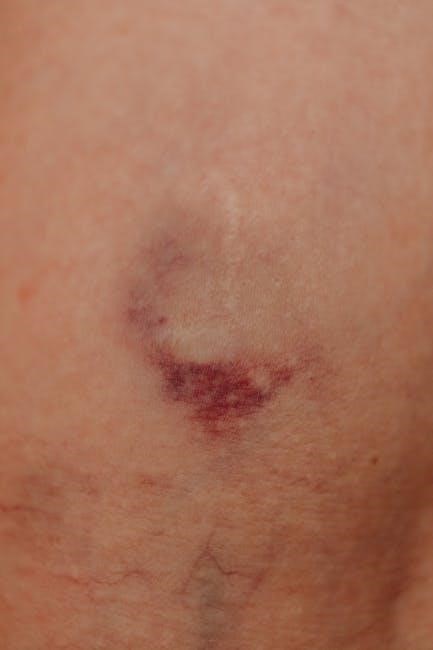
Simulation Training for EMTs
Simulation training immerses EMTs in realistic trauma scenarios, mimicking real-life emergencies to enhance decision-making and practical skills through hands-on experience and cutting-edge technology.
Virtual Patients and Real-Time Scenarios
Virtual patients and real-time scenarios provide immersive training for EMTs, simulating injuries and emergencies with lifelike accuracy. These tools allow EMTs to practice assessments, interventions, and decision-making in dynamic, high-pressure situations. Advanced technology creates realistic environments where trainees can interact with virtual patients, enhancing their ability to respond effectively in actual trauma cases. This method ensures EMTs are well-prepared for diverse emergencies, bridging the gap between theory and practical application in critical care scenarios.
Simulated Environments like Trauma Island
Simulated environments such as Trauma Island offer EMT trainees hands-on experience in realistic trauma scenarios. These immersive settings replicate real-world emergencies, allowing EMTs to practice patient assessment, stabilization, and transportation techniques under controlled conditions. Trainees engage in high-fidelity simulations, including vehicle collisions and mass casualty incidents, to refine their skills in dynamic, unpredictable situations. These environments enhance their ability to remain calm and make quick decisions, ensuring they are prepared for the challenges of real-life trauma response.
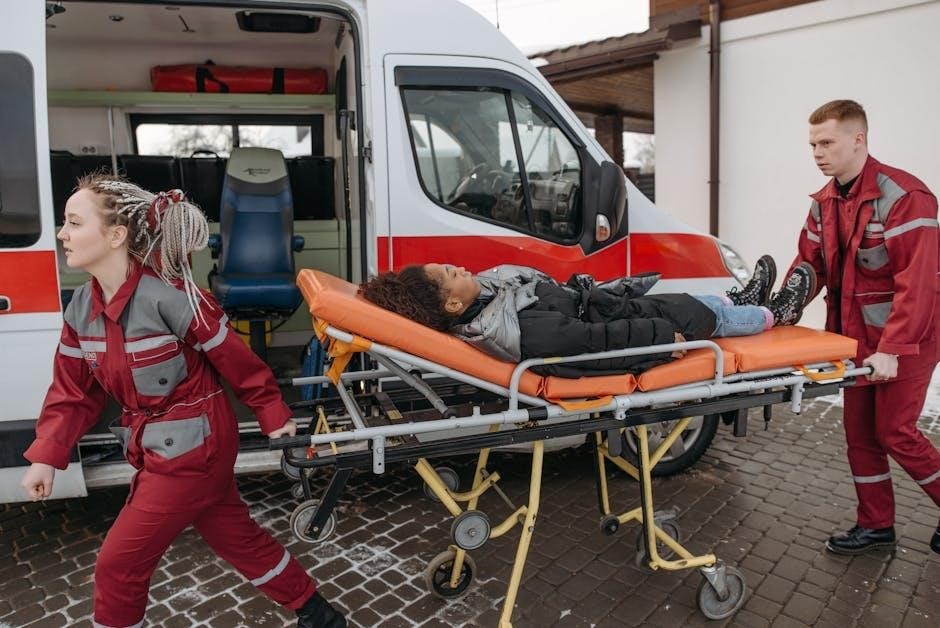
Real-Life Patient Assessment Scenarios
Real-life patient assessment scenarios expose EMTs to critical situations like multiple vehicle collisions and mass casualty incidents, enhancing their ability to diagnose and respond effectively under pressure.
Multiple Vehicle Collisions and Mass Casualty Incidents
Multiple vehicle collisions and mass casualty incidents present chaotic scenarios requiring rapid assessment and prioritization of patients. EMTs must quickly triage victims, stabilize the critically injured, and coordinate efficient transport to medical facilities. These situations demand strong decision-making skills, effective communication, and the ability to manage resources under intense pressure. Simulation training, such as Trauma Island, prepares EMTs to handle the unpredictability of such events, ensuring they can provide life-saving interventions in high-stress environments.
Heart Attacks and Severe Electric Shock Cases
Heart attacks and severe electric shock cases require immediate and precise interventions. EMTs must quickly assess symptoms, such as chest pain or burns, and initiate life-saving measures like CPR or AED use. These scenarios emphasize the importance of rapid decision-making and adherence to protocols. Training programs incorporate realistic drills, allowing EMTs to practice responding to cardiac emergencies and electrical injuries effectively, ensuring they can provide critical care in high-pressure situations.

Preparing for Trauma Scenarios
Preparing for trauma scenarios involves comprehensive checklists, adherence to protocols, and simulation training to ensure EMTs can respond effectively in high-pressure situations with precision and calmness.
Checklists and Protocols for Emergency Response
Checklists and protocols are essential for EMTs in trauma scenarios, ensuring systematic assessment and intervention. These tools guide EMTs through critical steps, from initial patient evaluation to stabilization techniques. Protocols often include algorithms for specific injuries, such as hemorrhage control or respiratory distress. By following established checklists, EMTs can prioritize actions, minimize errors, and deliver consistent care. Regular training on these protocols enhances adherence and improves response efficiency in high-stress situations, ultimately improving patient outcomes.
Mass Casualty Incident (MCI) Preparation
Mass Casualty Incident preparation is vital for EMTs to manage multiple injuries effectively. Protocols include triage systems, prioritizing critical patients, and coordinating resources. EMTs must communicate clearly with dispatch and other responders to allocate aid efficiently. Training involves simulated MCIs to enhance decision-making under pressure. Effective MCI preparation ensures rapid response, minimizing fatalities and improving outcomes in chaotic scenarios. Continuous drills and updated protocols keep EMTs ready for unpredictable events, ensuring seamless coordination and optimal patient care during emergencies.
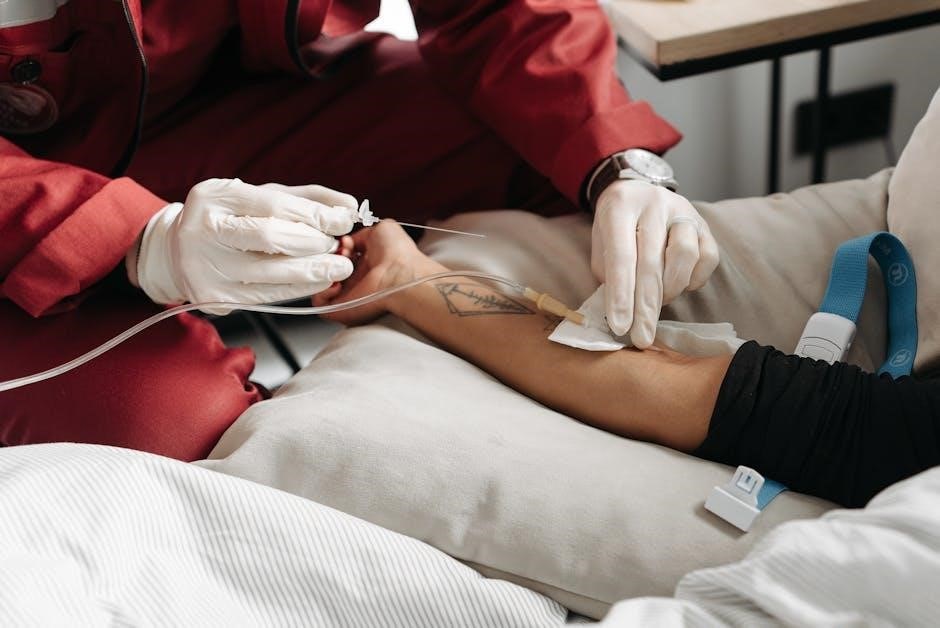
Patient Assessment Techniques
EMTs use advanced techniques like FAST and point-of-care ultrasonography to quickly assess and manage trauma patients, ensuring accurate diagnoses and timely interventions in emergency situations.
Focused Assessment with Sonography for Trauma (FAST)
FAST is a critical ultrasound protocol used by EMTs to rapidly identify internal injuries and bleeding in trauma patients. It focuses on four key areas: the pericardial, pleural, peritoneal, and retroperitoneal spaces. By scanning these regions, EMTs can quickly detect conditions like cardiac tamponade, hemothorax, or free intraperitoneal fluid, which are life-threatening. This tool enhances patient assessment accuracy, allowing for immediate decision-making and appropriate interventions in high-stress trauma scenarios.
Point of Care Ultrasonography in Trauma Care
Point of care ultrasonography is a vital tool in trauma care, enabling EMTs to perform rapid, bedside assessments of injured patients. This technology allows for the immediate detection of life-threatening conditions such as pneumothorax, hemorrhage, and cardiac compromise. By integrating ultrasound into trauma scenarios, EMTs can make informed decisions quickly, ensuring timely interventions and improving patient outcomes. Its portability and ease of use make it an indispensable asset in prehospital and emergency settings, enhancing the quality of trauma care provided.
Communication in Trauma Scenarios
Effective communication is vital in trauma scenarios, ensuring clear coordination between EMTs, patients, and other emergency services to provide timely and accurate care during critical situations.
Effective Patient Communication Strategies
Effective patient communication strategies in trauma scenarios involve active listening, clear instructions, and empathy. EMTs must rapidly assess patient conditions, convey reassurance, and gather vital information efficiently. Using simple, understandable language helps reduce patient anxiety and ensures compliance with care instructions. Additionally, maintaining eye contact and a calm demeanor can build trust, crucial in high-stress environments. These strategies are essential for providing optimal care and improving patient outcomes during emergencies.
Coordination with Emergency Services and Hospitals
Effective coordination between EMTs, emergency services, and hospitals ensures seamless patient care transitions. Clear communication via radio or digital systems helps prioritize resource allocation and prepare receiving facilities. EMTs must accurately convey patient statuses, injuries, and interventions to hospital teams, enabling prompt triage and treatment planning. This integration minimizes delays, enhances patient outcomes, and streamlines overall emergency response efforts during trauma scenarios.
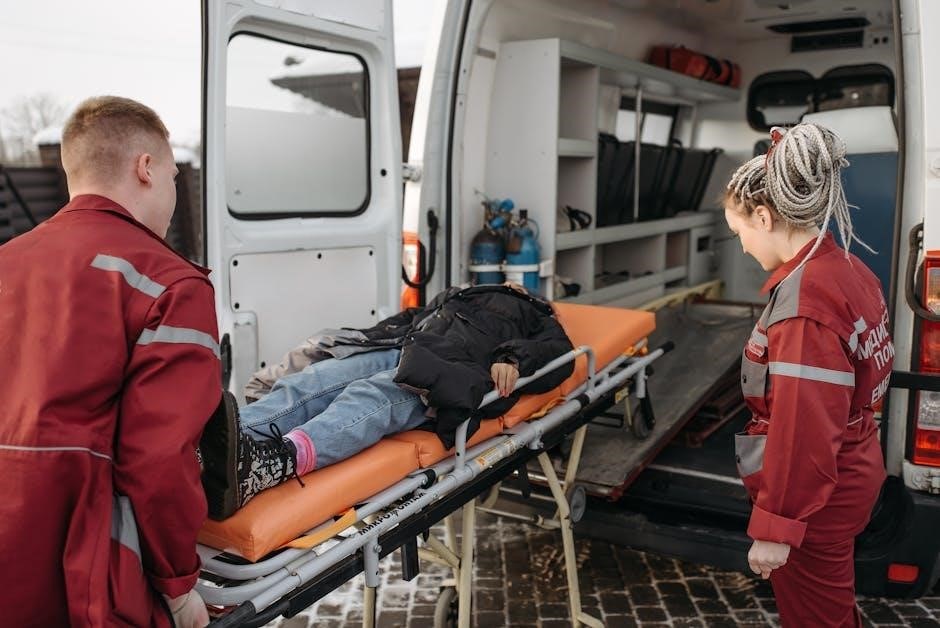
Technology in Trauma Training
Advanced tools like ultrasound systems and digital documentation enhance EMT training, offering realistic simulations and efficient data management for improved trauma response and education.
Ultrasound Training Systems for EMTs
Ultrasound training systems are integral to modern EMT education, enabling realistic simulations of trauma scenarios. These tools allow EMTs to practice scanning techniques and interpret findings in real-time, enhancing diagnostic accuracy. By integrating point-of-care ultrasonography, trainees can master the Focused Assessment with Sonography for Trauma (FAST) protocol, crucial for identifying internal injuries. Such systems provide immersive learning experiences, improving decision-making and patient outcomes in high-pressure situations. They bridge the gap between theory and practice, ensuring EMTs are adept at using ultrasonography effectively during emergencies.
Digital Documentation Tools for Trauma Scenarios
Digital documentation tools streamline data collection during trauma scenarios, enabling EMTs to efficiently record patient information. These tools facilitate real-time data entry, reducing errors and improving communication with healthcare teams. By integrating with training systems, they provide comprehensive records of simulations, aiding in post-scenario analysis. Digital tools enhance documentation accuracy, ensuring seamless continuity of care and fostering improved learning outcomes for trainees. They are indispensable in modern trauma training, bridging the gap between simulation and real-world application effectively.

Emotional Resilience for EMT Trainees
EMT trainees build emotional resilience through realistic trauma scenarios, preparing them to manage stress and maintain composure in life-threatening situations, fostering long-term mental well-being.
Dealing with Success and Failure in the Field
EMT trainees encounter both success and failure in trauma scenarios, learning to adapt and grow from outcomes. Realistic simulations help build resilience, teaching trainees to remain composed and focused. Success reinforces effective techniques, while failures highlight areas for improvement, fostering a growth mindset. Emotional resilience is cultivated through exposure to diverse, high-stress situations, ensuring trainees can navigate challenges with confidence and professionalism in real-world emergencies.
Building Emotional Strength Through Realistic Scenarios
Realistic trauma scenarios are pivotal in fostering emotional strength among EMT trainees. Exposure to simulated high-stress environments mirrors real-life incidents, enabling trainees to develop coping mechanisms and emotional resilience. These exercises help trainees manage anxiety and stress, crucial for maintaining professionalism under pressure. By confronting challenging situations in a controlled setting, trainees build confidence and emotional fortitude, ensuring they are prepared to handle the psychological demands of emergency medical services effectively.
Continuous training in trauma response is essential for EMTs to stay prepared, ensuring effective patient care and optimal outcomes in emergencies.
The Importance of Continuous Training in Trauma Response
Continuous training ensures EMTs stay updated with advanced protocols and technologies, enhancing their ability to handle diverse trauma scenarios effectively. Regular drills and simulations improve decision-making and skill retention, crucial for saving lives. Realistic scenarios and feedback loops help refine techniques, while exposure to new tools like ultrasound systems keeps responders prepared for modern challenges. Ongoing education fosters adaptability and resilience, ensuring high-quality care in ever-evolving emergency situations.
